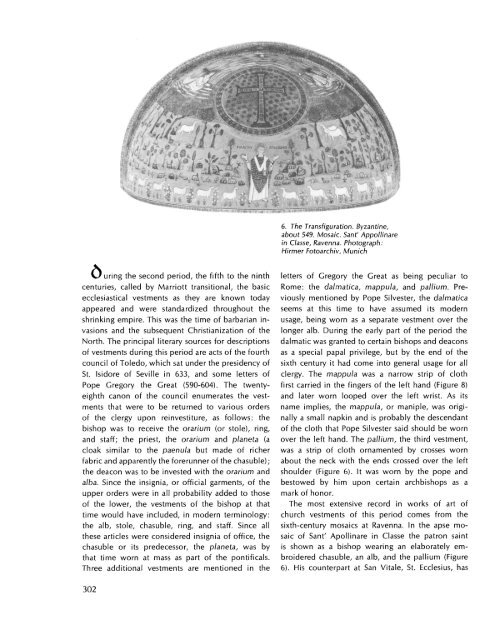The Metropolitan Museum of Art Bulletin, v. 29, no. 7 (March, 1971)
The Metropolitan Museum of Art Bulletin, v. 29, no. 7 (March, 1971)
The Metropolitan Museum of Art Bulletin, v. 29, no. 7 (March, 1971)
Create successful ePaper yourself
Turn your PDF publications into a flip-book with our unique Google optimized e-Paper software.
6. <strong>The</strong> Transfiguration. Byzantine,<br />
about 549. Mosaic. Sant' Appollinare<br />
in Classe, Ravenna. Photograph:<br />
Hirmer Fotoarchiv, Munich<br />
uring the second period, the fifth to the ninth<br />
centuries, called by Marriott transitional, the basic<br />
ecclesiastical vestments as they are k<strong>no</strong>wn today<br />
appeared and were standardized throughout the<br />
shrinking empire. This was the time <strong>of</strong> barbarian invasions<br />
and the subsequent Christianization <strong>of</strong> the<br />
North. <strong>The</strong> principal literary sources for descriptions<br />
<strong>of</strong> vestments during this period are acts <strong>of</strong> the fourth<br />
council <strong>of</strong> Toledo, which sat under the presidency <strong>of</strong><br />
St. Isidore <strong>of</strong> Seville in 633, and some letters <strong>of</strong><br />
Pope Gregory the Great (590-604). <strong>The</strong> twentyeighth<br />
ca<strong>no</strong>n <strong>of</strong> the council enumerates the vestments<br />
that were to be returned to various orders<br />
<strong>of</strong> the clergy upon reinvestiture, as follows: the<br />
bishop was to receive the orarium (or stole), ring,<br />
and staff; the priest, the orarium and planeta (a<br />
cloak similar to the paenula but made <strong>of</strong> richer<br />
fabric and apparently the forerunner <strong>of</strong> the chasuble);<br />
the deacon was to be invested with the orarium and<br />
alba. Since the insignia, or <strong>of</strong>ficial garments, <strong>of</strong> the<br />
upper orders were in all probability added to those<br />
<strong>of</strong> the lower, the vestments <strong>of</strong> the bishop at that<br />
time would have included, in modern termi<strong>no</strong>logy:<br />
the alb, stole, chasuble, ring, and staff. Since all<br />
these articles were considered insignia <strong>of</strong> <strong>of</strong>fice, the<br />
chasuble or its predecessor, the planeta, was by<br />
that time worn at mass as part <strong>of</strong> the pontificals.<br />
Three additional vestments are mentioned in the<br />
letters <strong>of</strong> Gregory the Great as being peculiar to<br />
Rome: the dalmatica, mappula, and pallium. Previously<br />
mentioned by Pope Silvester, the dalmatica<br />
seems at this time to have assumed its modern<br />
usage, being worn as a separate vestment over the<br />
longer alb. During the early part <strong>of</strong> the period the<br />
dalmatic was granted to certain bishops and deacons<br />
as a special papal privilege, but by the end <strong>of</strong> the<br />
sixth century it had come into general usage for all<br />
clergy. <strong>The</strong> mappula was a narrow strip <strong>of</strong> cloth<br />
first carried in the fingers <strong>of</strong> the left hand (Figure 8)<br />
and later worn looped over the left wrist. As its<br />
name implies, the mappula, or maniple, was originally<br />
a small napkin and is probably the descendant<br />
<strong>of</strong> the cloth that Pope Silvester said should be worn<br />
over the left hand. <strong>The</strong> pallium, the third vestment,<br />
was a strip <strong>of</strong> cloth ornamented by crosses worn<br />
about the neck with the ends crossed over the left<br />
shoulder (Figure 6). It was worn by the pope and<br />
bestowed by him upon certain archbishops as a<br />
mark <strong>of</strong> ho<strong>no</strong>r.<br />
<strong>The</strong> most extensive record in works <strong>of</strong> art <strong>of</strong><br />
church vestments <strong>of</strong> this period comes from the<br />
sixth-century mosaics at Ravenna. In the apse mosaic<br />
<strong>of</strong> Sant' Apollinare in Classe the patron saint<br />
is shown as a bishop wearing an elaborately embroidered<br />
chasuble, an alb, and the pallium (Figure<br />
6). His counterpart at San Vitale, St. Ecclesius, has<br />
302

















